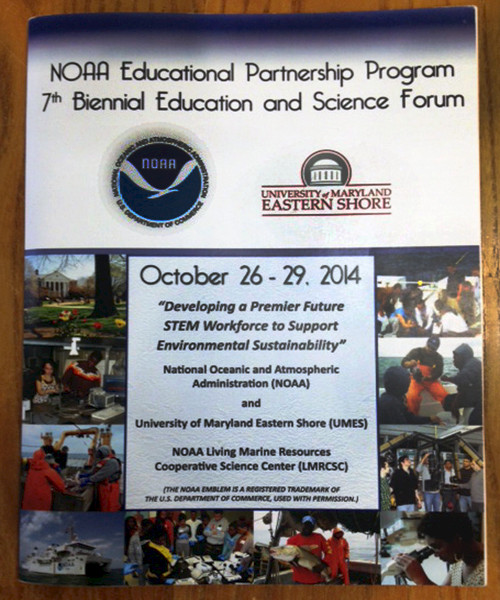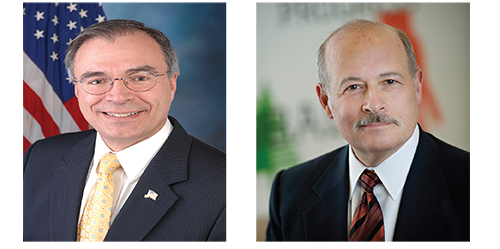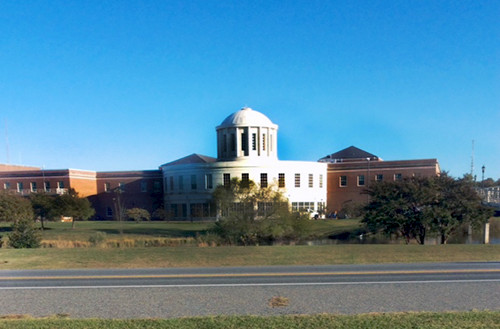Enhancing diversity in environmental sciences through the NOAA Educational Partnerships Program
Bill Dennison ·The 7th biennial Education and Science Forum sponsored by the National Oceanographic and Atmospheric Administration Educational Partnerships Program (NOAA-EPP) was held on the beautiful campus of the University of Maryland Eastern Shore (UMES) during some spectacular autumn weather (Oct 24-26). I attended this forum with the theme; “Developing a Premier Future STEM Workforce to Support Environmental Sustainability” which was followed by the annual meeting of the Living Marine Resources Cooperative Science Center (LMRCSC), one of four Cooperative Science Centers. The 4 Cooperative Research Centers supported by NOAA are based at Howard University focused on climate, Florida A&M University focused on coastal resources of the Gulf of Mexico, City University of New York focused on remote sensing and UMES focused on living marine resources. The University of Maryland Center for Environmental Science is involved with the LMRCSC through the Institute of Marine Environmental Technology program headed by Dr. Rose Jagus.

The kick off for the Education and Science Forum was an impressive panel: Dr. Juliette Bell, President of UMES, Dr. Kathy Sullivan, NOAA Administrator, Dr. Joann Boughman, Senior Vice Chancellor of Academic Affairs at the University System of Maryland, and Dr. Andy Harris, U.S. Congressman from Maryland's First District. Juliette Bell is an African-American biochemist and she was able to personally relate to the need to develop more diversity in the STEM (Science Technology Engineering Math) fields. She provided a welcome to the forum and introduced the UMES team who were responsible for organizing the NOAA-EPP forum, especially Dr. Paulinus Chigbu.
Kathy Sullivan introduced the term "Environmental Intelligence" which she defined as "turning scientific results into insight and foresight". Examples that she gave included hurricane forecasting, the PORTS program in Chesapeake Bay of smart bouys that provide realtime environmental information to ships, and Harmful Algal Bloom forecasting in the Gulf of Mexico. Kathy has a background in oceanography and also was an astronaut and talked about environmental intelligence as converting observations, monitoring, assessment and modeling into forecasts and products with the priorities of 1) Making communities more resilient, 2) Evolving the weather service, 3) Investing in observational infrastructure, and 4) Achieving organizational excellence. Kathy provided the vision of making NOAA America's environmental intelligence agency and her talk served as an effective recruiting outreach to the many NOAA-EPP students attending the forum.
Jo Boughman talked about developing a premier future STEM workforce to support environmental sustainability. She quoted the Norm Augustine article in Forbes magazine in which Norm said that global leadership by the U.S. in science and technology is not a birthright, but needs to be earned. Jo talked about how Maryland has increased the graduation rate in STEM fields. She also touched on environmental sustainability, highlighting the role of my boss Don Boesch as Vice Chancellor for Environmental Sustainability of the University System of Maryland and the leadership of UMES in sustainability (e.g., green buildings, solar energy farm). She mentioned that currently 25% of the global population is children, but they comprise 100% of the future. Jo concluded by alluding to 'Starship Earth' and encouraged us to be the best crew members on the starship.

Andy Harris was introduced as "The Doctor in the House", referring to the fact that he is a clinical anesthesiologist who serves in the U.S. House of Representatives. He is the only scientist on the Appropriations Committee. Andy reminded us that the government science budget does not get passed by scientists, so scientists need to be able to make their case for funding to non-scientists. He talked about the biomedical research budget that he is familiar with and highlighted that $129 billion dollars is spent on biomedical research and government investments constitute 40% of the total budget. He recommended that scientists talk with watermen and farmers to better understand the science needs of the community. As a scientist, he also recommended keeping an open mind about issues and using sound science for environmental management.
Following this session, Jo remarked that her panel was a first for her. She said that she had never been one of three women on the same panel, all with PhD degrees in science who serve in leadership positions. Jo was right: Dr. Bell with her PhD in biochemistry is a university president, Dr. Sullivan with her PhD in oceanography is the NOAA Administrator and Dr. Boughman with her PhD in genetics is a vice-chancellor. The additional panel member Dr. Harris has an M.D. Degree and is a Congressman. Quite an impressive group.

Dr. Rick Spinrad, NOAA Chief Scientist spoke how NOAA is focused on mission-oriented science, turning data into information/knowledge/assessments into decisions into actions. He talked about NOAA's role in Hurricane Sandy forecasting and preparation, and that for some people "NOAA saved Christmas". He noted that while NOAA's Weather Service has been better able to predict tornados, the death rate has not decreased due to the lack of control of how people use the data. He highlighted the need for better social and economic science to address this issue. During the question and answer session, I asked Rick about the chronic failures in fisheries management when fisheries biologists would recommend reduced catches or other management interventions which were often ignored, resulting in fisheries collapses. Rick answered that the National Science Foundation had strengths in social, behavioral and economic sciences and NOAA is looking to build partnerships with these programs. Rick also gave specific examples of mission oriented research at each of the NOAA-EPP programs. He provided the following numbers about the EPP program: 1600 STEM graduates, 83% from underrepresented minority groups, 190 graduates work in the private sector, 81 graduates work at NOAA. Since the goal of the NOAA-EPP is to increase the number of students from underrepresented communities who are educated, trained and graduated in fields that directly support NOAA's mission, it was encouraging that NOAA-EPP alumni were being entrained into the workforce.
As good as these plenary talks were, the highlight for me was the interaction with the bright young graduate students that I met. They were very engaging and enthusiastic. The students are from a variety of different institutions, both HBCU (Historically Black Colleges & Universities) and mainstream institutions. These students are involved in exciting research projects and after watching several minority students start out with so little but end up with so much in the way of scientific skills, poise and capability, I have seen how effective this program can be. Also, UMCES has benefited from a conduit with undergraduate training at a various HBCUs, like UMES and Hampton University. I look forward to watching this diversity grow and further permeate marine science.

About the author
Bill Dennison

Dr. Bill Dennison is a Professor of Marine Science and Vice President for Science Application at the University of Maryland Center for Environmental Science.

